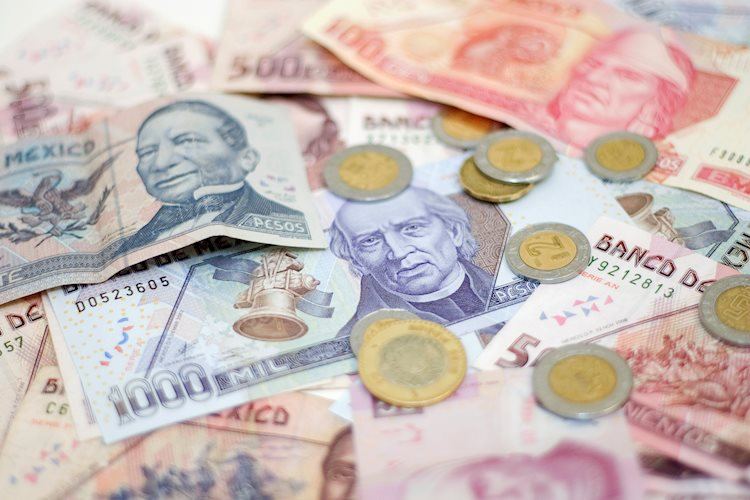- Mexican Peso appreciates more than 0.30%, despite losing some ground.
- US producer-side inflation ticked up slightly, though the market eyes upcoming FOMC minutes and CPI.
- Interest rate differentials favor USD/MXN downside, though is at the mercy of the Fed shifting its rhetoric.
Mexican Peso (MXN) appreciated further during the North American session, particularly against the Greenback (USD). Even though the USD has trimmed some of its earlier losses as witnessed by the USD/MXN bouncing off the daily lows of 17.78 to current exchange rates around 17.84, it remains at the mercy of falling US Treasury bond yields.
Sentiment has shifted mixed, implying that there would be less appetite for risk-perceive currencies like the Mexican Peso. The latest round of economic data from the United States (US) showed that inflation on the producer side increased slightly, as traders brace for tomorrow’s Consumer Price Index (CPI) release. In addition, the latest Federal Reserve (Fed) Open Market Committee (FOMC) minutes are muchly awaited, as traders look for clues on the forward path of monetary policy, despite the recent dovish approach adopted by Fed officials. In the meantime, the interest rate difference between Mexico and the United States favors the former, which means, further USD/MXN downside is expected unless Fed officials shift hawkish.
Daily Digest Market Movers: Mexican Peso loses some steam, as sellers target 17.90
- Mexican Peso remains bolstered by a risk-on impulse despite the ongoing escalation of the Israel-Hamas conflict.
- The September US Producer Price Index (PPI) rose by 0.5% MoM, above estimates of 0.3%, while core PPI expanded by 0.3%, exceeding estimates of 0.2%.
- Annually based, the PPI rose by 2.2%, above forecasts and August’s figures, of 1.6% and 2%, while the core PPI rate stood at 2.7%, exceeding projections and the prior month’s data.
- Fed Governor Michelle Bowman: As inflation remains above the FOMC’s target, “This suggests that the policy rate may need to rise further and stay restrictive for some time to return inflation to the FOMC’s goal.”
- Mexico’s Consumer Price Index (CPI) grew by 4.45% YoY in September, below the 4.47% of estimates.
- The core CPI inflation in Mexico stood stickier at 5.76% YoY, as widely estimated, but has broken below the 6% threshold.
- The Bank of Mexico (Banxico) held rates at 11.25% in September and revised its inflation projections from 3.5% to 3.87% for 2024, above the central bank’s 3% target (plus or minus 1%).
Technical Analysis: Mexican Peso rebounds at around 17.77 as buyers target higher prices
Mexican Peso appreciated during the week as the USD/MXN has dived more than 3%, below the 18.00 figure, with sellers targeting the 200-day Simple Moving Average (SMA) at 17.77. A breach of the latter will expose the 20-day SMA at 17.57 before challenging the low seen on September 30 at 17.34. If USD/MXN sellers break that level, the pair will shift to a neutral-downward bias. On the flip side, buyers must reclaim the 18.00 figure for a bullish continuation.
Inflation FAQs
Inflation measures the rise in the price of a representative basket of goods and services. Headline inflation is usually expressed as a percentage change on a month-on-month (MoM) and year-on-year (YoY) basis. Core inflation excludes more volatile elements such as food and fuel which can fluctuate because of geopolitical and seasonal factors. Core inflation is the figure economists focus on and is the level targeted by central banks, which are mandated to keep inflation at a manageable level, usually around 2%.
The Consumer Price Index (CPI) measures the change in prices of a basket of goods and services over a period of time. It is usually expressed as a percentage change on a month-on-month (MoM) and year-on-year (YoY) basis. Core CPI is the figure targeted by central banks as it excludes volatile food and fuel inputs. When Core CPI rises above 2% it usually results in higher interest rates and vice versa when it falls below 2%. Since higher interest rates are positive for a currency, higher inflation usually results in a stronger currency. The opposite is true when inflation falls.
Although it may seem counter-intuitive, high inflation in a country pushes up the value of its currency and vice versa for lower inflation. This is because the central bank will normally raise interest rates to combat the higher inflation, which attract more global capital inflows from investors looking for a lucrative place to park their money.
Formerly, Gold was the asset investors turned to in times of high inflation because it preserved its value, and whilst investors will often still buy Gold for its safe-haven properties in times of extreme market turmoil, this is not the case most of the time. This is because when inflation is high, central banks will put up interest rates to combat it.
Higher interest rates are negative for Gold because they increase the opportunity-cost of holding Gold vis-a-vis an interest-bearing asset or placing the money in a cash deposit account. On the flipside, lower inflation tends to be positive for Gold as it brings interest rates down, making the bright metal a more viable investment alternative.
